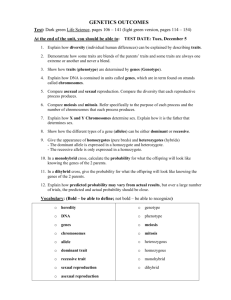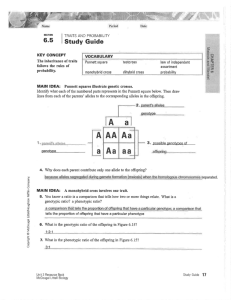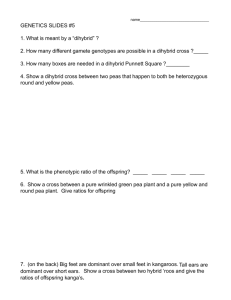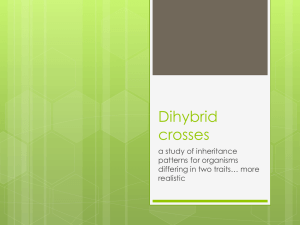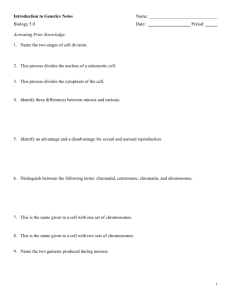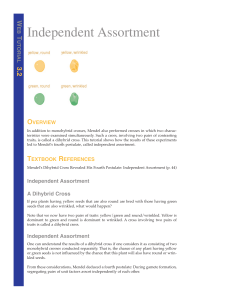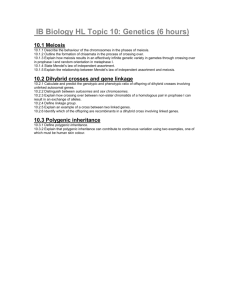Mendel's Fourth Postulate
advertisement
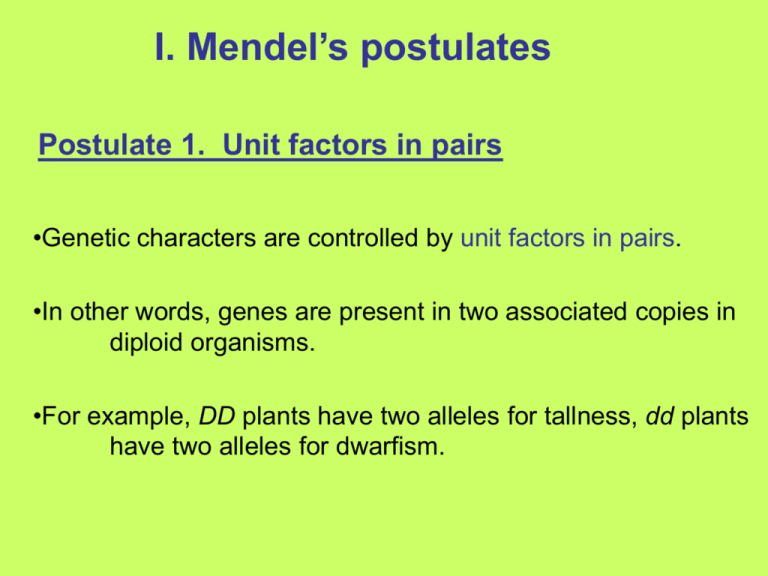
I. Mendel’s postulates Postulate 1. Unit factors in pairs •Genetic characters are controlled by unit factors in pairs. •In other words, genes are present in two associated copies in diploid organisms. •For example, DD plants have two alleles for tallness, dd plants have two alleles for dwarfism. Postulate 2. Dominance/recessiveness •In the case of unlike unit factors, one can be dominant and the other can be recessive. •In other words, when two different alleles of a gene are present, one may show its effect while the other may be masked. •For example, Dd plants have a tall allele D and a dwarf allele d, but are phenotypically tall. Postulate 3. Segregation •During the formation of gametes, unit factors segregate randomly. •In other words, when sperm and eggs are formed, one of each allelic pair is randomly distributed to to each gamete. •For example, a Dd plant makes pollen or eggs, each randomly receives either the D allele or the d allele. IV. Independent assortment Mendel’s Fourth Postulate: An Interpretation from the Dihybrid cross • During gamete formation, segregating pairs of unit factors assort independently. • In other words, segregation of 2 alleles at one genetic locus has no effect on the segregation of 2 alleles at another locus (unless linked). • For example, the assortment of yellow and green alleles has no effect on the assortment of round and wrinkled alleles, and vice versa. Independent Assortment • Results in extensive genetic variation • Number of possible gametes = 2n where n is the haploid number • For humans, 223 = 8 million • Each individual represents one of (8 X 106)2 = 64 X 1012 possible genetic combinations from her parents Practice: Yellow/Green Peas •In garden peas, an allele Y for yellow peas are dominant to an allele y for green peas. •If we crossed 2 heterozygous pea plants What would be the expected genotypes of the F1 generation (progeny)? Need to set up a punnett square to predict possible outcomes Further prediction powers – In the F2 generation of a monohybrid cross, what is the expected ratio of Yellow : Green? – Depends on which of the F1 progeny will be crossed – Lets review the outcome of the F1 • 50% Heterozygotes • 25% Homozygotes Recessive • 25% Homozygotes Dominant II. Monohybrid Test Cross (Backcross) • How can you determine genotype from individual expressing dominant phenotype? - DD or Dd? • Cross individual with dominant phenotype to a homozygous recessive individual. Dihybrid Cross: P1 cross Since yellow and round are dominant, Let G = yellow, g = green, W = round, w = wrinkled. What would the F2 progeny look like? Dihybrid Cross: F1 cross III. Dihybrid cross - phenotypes 1.Which traits are dominant? 2. Did the phenotypes of the P1 generation affect the F1 or F2 generations? Dihybrid Cross: Summary 9 3 3 1 An Easier Way? • Called the “Fork Line Method” • This is just another way to be able to predict genotype and phenotype ratios in dihybrid problems • this way you don’t have to write the box • but it does require you to know the basic ratios that arise from monohybrids • based on the idea that: in a dihybrid, the two traits sort INDEPENDENTLY of one another • i.e. what happens with one trait is completely unrelated to what happens with the other trait PpYy x PpYy so to solve this dihybrid, separate the two traits (since they sort independently): Pp x Pp will give: ¼ PP ½ Pp ¼ pp PpYy x PpYy so to solve this dihybrid, separate the two traits (since they sort independently): Pp x Pp will give: similarly, Yy x Yy will give: ¼ YY ½ Yy ¼ yy ¼ PP ½ Pp ¼ pp PpYy x PpYy so to solve this dihybrid, separate the two traits (since they sort independently): Yy x Yy will give: Pp x Pp will give: ¼ YY ½ Yy ¼ yy ¼ YY ¼ PP ½ Pp ¼ pp multiply fractions 1/16 PPYY ½ Yy 1/8 PPYY ¼ yy 1/16 PPYY PpYy x PpYy so to solve this dihybrid, separate the two traits (since they sort independently): Pp x Pp will give: ¼ YY ¼ PP ½ Pp ¼ pp multiply fractions 1/16 PPYY ½ Yy 1/8 PPYy ¼ yy 1/16 PPyy ¼ YY 1/8 PpYY ½ Yy 1/4 PpYy ¼ yy 1/8 Ppyy ¼ YY 1/16 ppYY ½ Yy 1/8 ¼ yy 1/16 ppyy ppYy PpYy x PpYy so to solve this dihybrid, separate the two traits (since they sort independently): convert all to 16ths for consistency Pp x Pp will give: 1/16 PPYY 1 ½ Yy 1/8 PPYy 2 ¼ yy 1/16 PPyy 1 ¼ YY 1/8 PpYY 2 ½ Yy 1/4 PpYy 4 ¼ yy 1/8 Ppyy 2 ¼ YY 1/16 ppYY 1 ½ Yy 1/8 ppYy 2 ¼ yy 1/16 ppyy 1 ¼ YY ¼ PP ½ Pp ¼ pp multiply fractions PpYy x PpYy so to solve this dihybrid, separate the two traits (since they sort independently): convert all to 16ths for consistency Pp x Pp will give: 1/16 PPYY 1 ½ Yy 1/8 PPYy 2 ¼ yy 1/16 PPyy 1 ¼ YY 1/8 PpYY 2 ½ Yy 1/4 PpYy 4 ¼ yy 1/8 Ppyy 2 ¼ YY 1/16 ppYY 1 ½ Yy 1/8 ppYy 2 ¼ yy 1/16 ppyy 1 ¼ YY ¼ PP ½ Pp ¼ pp multiply fractions so – this gives you the same results as the Punnet square – but in some cases might be a faster cleaner way of doing it. Analysis of dihybrid cross phenotypes (forked-line/probability method) Trait 1 Trait 2 Combined traits Fork Line Practice • Fruit Fly Genotypes – Ebony (e) – Gray (E) – Long wings (V) – Vestigial wings (v) Find the phenotype probabilities of a diheterozygote female crossed with a diheterozygote male for: 1) Grey and vestigial 2) Ebony and Long V. Gamete Formation: Trihybrid cross What size of Punnett square needed for analysis? Use the Forkline! • Possible Gametes – AaBbCc X AaBbCc Trihybrid Cross - Phenotypes Forked-line Method 27:9:9:9:3:3:3:1 Product law • For simultaneous outcomes (AND) • What is the chance that you will roll snake eyes with two dice? (1 and 1) – Chance of rolling 1 with first die = 1/6 – Chance of rolling 1 with second die = 1/6 – Chance of rolling two 1’s = 1/6 X 1/6 = 1/36 • We used product law when calculating probabilities by the forked-line method. Sum law • For outcomes that can occur more than one way (OR) • What is the chance that you will roll either a 1 or a 6 with one die? – Chance of rolling 1 = 1/6 – Chance of rolling 6 = 1/6 – Chance of rolling 1 or 6 = 1/6 + 1/6 = 2/6 = 1/3 VI. Molecular Basis of Mendel’s Postulates: Chromosome behavior • 1879: Walter Flemming discovers chromosomes in living cells. • 1900: DeVries, Correns, and Tschermak repeat, rediscover Mendel. • 1902: Sutton and Boveri and others link behavior of chromosomes to Mendelian segregation and independent assortment; propose chromosomal theory of heredity. Theodor Boveri • Hypothesis: Removal of chromosomes should result in some change to organism. • Did this in sea urchin embryos, saw abnormal embryos. 1862-1915 Walter Sutton (1877-1916) • Studied grasshopper testis and ovary cells, observed that haploid numbers of chromosomes mixed to form diploid set. • Noted that this chromosome behavior correlated with Mendel’s genes, and proposed that genes are carried on the chromosomes. Correlation Between Unit Factors and Genes on Chromosomes • Unit factors in pairs ~ genes on homologous chromosomes in pairs • Segregation of unit factors during gamete formation ~ genes on homologs segregate during meiosis • Independent assortment of segregating unit factors ~ genes on nonhomologous chromosomes assort independently • Stronger evidence for the chromosomal theory of heredity came from experiments of T.H. Morgan and others with fruit flies from 1909 onwards. VII. Laws of probability help explain genetic events Genetic ratios are most properly expressed as probabilities: ex. 3/4 tall: 1/4 dwarf The probability of each zygote having the genetic potential for becoming tall is 3/4, etc.. Probabilities range from 0 (an event is certain NOT to happen), to 1.0 (an event is certain to happen). How do we calculate the probability of 2 or more events happening at the same time?
